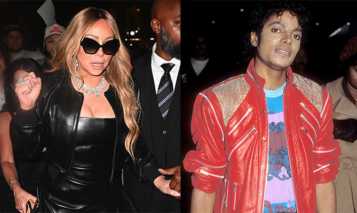Mariah Carey and boyfriend Bryan Tanaka are seen exiting Mastro’s steakhouse restaurant after celebrating Bryan’s 35th birthday. Mariah recently revealed her battle with bipolar disorder in an interview with PEOPLE.
“I didn’t want to believe it,” tells PEOPLE of her diagnosis in 2001 after a mental breakdown.
Bipolar disorder, formerly known as manic-depression, is a mood disorder characterized by significant wild mood swings from depression to hyper mania, lack of energy and poor judgment, such as spending sprees.
Millions of Americans are diagnosed with bipolar disorder, but millions more have no idea they have the disorder (especially within the black community).
Black people who go to their regular practitioner, instead of a psychiatrist, are often misdiagnosed or not diagnosed at all.
We all have a friend or family member who seems to be moody and quiet on some days, then on other days she excitedly shows off the new Gucci or Prada handbags and shoes she purchased that you know she can’t afford to buy.
That doesn’t mean people who spend recklessly are manic-depressive. Often we take action or suggest they seek therapy when their behavior disrupts their daily lives.
People who have bipolar disorder tend to lose interest in activities or they don’t finish projects they started. They can be very moody one minute then seem high or euphoric the next minute.
Patients with severe forms of bipolar disorder find their lives disrupted when they spend the rent and car payments on unnecessary items such as brand name clothes and handbags. Or they constantly interrupt their co-workers or classroom because they can’t sit still or stop talking.
People with bipolar disorder are often fired from their jobs, which can worsen their depression leading them to self-medicate with drugs and alcohol.
Symptoms
The symptoms of bipolar disorder can be categorized in several subtypes, each with a different pattern of symptoms.
Cyclothymic disorder is a mild form of bipolar disorder in which mania and depression can be disruptive, but not as severe as they are with other types of bipolar disorder.
Bipolar II disorder is less severe than bipolar I and is the most undiagnosed of the bipolar disorders. People with bipolar II have an elevated mood, irritability, but their symptoms don’t necessarily disrupt their daily functions. They have a less severe form of mania, and their periods of depression typically last longer than periods of low mania.
Bipolar I disorder is the most serious. These people are most often fired from their jobs for causing disruptions. They also have difficulty maintaining stable relationships. Manic episodes can be severe and dangerous, according to the Mayo Clinic.
Manic Phase of bipolar disorder Signs and Symptoms
Depressive phase of bipolar disorder Signs and Symptoms
Treatment
Bipolar disorder requires lifelong treatment, according to the Mayo Clinic. Treatment includes hospitalization, medications and intensive therapy. Patients are treated for their symptoms as well as for substance abuse.
Medications include Lithium to control mood changes, Anticonvulsants to control seizures, Antipsychotics (Zyprexa, Abilify, Risperdal), Antidepressants, and Anti-anxiety meds (Valium, Klonopin, Ativan, Xanax) to control anxiety.
This has been your Medical Minute.
More Info On the Web
Bipolar Disorder – Mayo Clinic
Bipolar Disorder – Web MD
The Problem With How We Treat Bipolar Disorder – The NY Times
Bipolar Disorder – American Psychological Association
DISCLAIMER
Any medical information published on this blog is for your general information only and is not intended as a substitute for informed medical advice. You should not take any action before consulting with your personal physician or a health care provider. Sandrarose.com and its affiliates cannot be held liable for any damages incurred by following advice found on this blog.
Photos by GAMR / Roger / BACKGRID

















